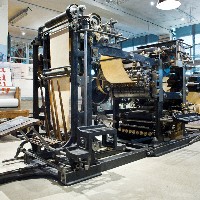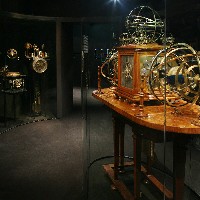Breadcrumbs navigation
National Technical Museum (Národní technické muzeum)
The seat of the museum is monumental functionalist building near Letná Park. The museum was founded in 1908, and for over a hundred years it has built an extensive collection documenting the development of many technical fields, natural and exact sciences and industry. Unique collection items can be viewed in 16 permanent exhibitions as well as temporary exhibitions.
Opening hours
-
- Januari – December
- dinsdag, woensdag, donderdag, vrijdag, zaterdag, zondag
- 09.00 – 18.00
Entrance fee
- basic 280 CZK
- reduced 150 CZK
- family 560 CZK
Practical information
PERMANENT EXHIBITION:
The exhibition Architecture, Engineering and Design presents major architectural achievements in the Czech Republic from 1860 to 1989.
The exhibition Astronomy is conceived as infinite space of the universe full of shining stars - a unique collection of objects.
The Transportation exhibition introduces the historical development of automobiles, motorcycles, bicycles, air, sea and rail transport, and fire equipment in individual narratives.
The development of photography and its use and influence from the 19th century to the present are presented together with basic photographic processes and their evolution in a stylized photographic studio in the exhibition Photo-Cinema.
The exhibition Printing evokes the authentic atmosphere of a printer’s and introduces the development of the main printing technologies and follow their development from the invention of printing to the present.
A retrospective look into several time periods from the present day to the mid-19th century is offered by the exhibition Technology in the Home.
The main theme of the exhibition Chemistry Around Us is the story of man and chemistry meeting throughout during the day, and also presents laboratory work methods in the past and the present.
The exhibition Measuring Time shows the technical development of chronometry. Its special focus is on the development of domestic watchmaking, whose origins are can already be seen during the reign of the Luxembourgs.
Mining machinery and mining equipment throughout history form the exhibition Mining. The most important aspect of the exhibition is a mock ore and coal mine from the 1950s, whose corridors extend to an area of 350 m².
The exhibition Metallurgy / Metals - the Path of Civilization traces the technical and historical development of metallurgy and its connection to society, which was influenced most of all by iron.
The exhibition Interkamera / Space, Color and Movement acquaints the viewer with historical and contemporary types of spatial photography. It presents all the basic photochemical processes of colour photography, principles of digital photography, and the development of photographic motion capture.
Due to the nature of the exhibition, the TV Studio exhibition is accessible only with a guide, who will demonstrate to visitors how studio equipment works.
The interactive exhibition Game Technology shows the principles of fingerprints, ballistics, coding documents, and more through a series of exhibits.
Of special interest is the Van de Graaff generator. This is an high voltage electrostatic generator, into which is integrated a linear charged particle accelerator.
Contacts
- National Technical Museum (Národní technické muzeum)
- Kostelní 42
- 170 00 Praha 7 – Holešovice
- +420220399111
- +420220399101
Object history
Collections of the Emperor Rudolf II, who in addition to collecting art also collected various technical devices, some of which are exhibited here, can be considered an ancestor of today’s museum. The technical collections were also enriched by the Jesuits, who founded the Museum Mathematicum in 1722 and Vojta Náprstek, the founder of the Czech Industrial Museum in 1873 (the original intention of the museum had been to increase the level of technical education and information on technical innovations in the world, but later it focused more on ethnography).
At that time the General Land Jubilee Exhibition in 1891 was the largest exhibition of technical equipment and devices in our country. Exhibits remained there long after the exhibition had been closed and at that time the Committee of the Museum of inventions was created and attempted to get a permanent building for these exhibits. From 1907 there were discussions of building a technical museum in Prague. The Trading Chamber Exhibition held in 1908 introduced a number of other models of buildings, machines and technical equipment and an additional collection fund for the future museum. The impulse to gather collections was given by the Technical University professors and as early as in 1908 the foundation meeting of the Technical Museum of the Czech Kingdom, later Society of the Technical Museum, was held.
Thanks to the generosity of Prince Schwarzenberg current collections in Schwarzenberg Palace at Hradčandské Square were opened for public in 1910. There were exhibitions of the engineering, glass industry, water supply, aviation, textiles industry, sugar industry, geodesy, transport, architecture etc. here. In 1921, cash collections had been started for a new museum building, Prague City Hall had provided a land near the water tower in Letná and in 1935 an architectural competition for the joint construction of the buildings for the collections of the Technical and Agricultural Museums was declared. The project by architect prof. Milan Babuška had been chosen and the decision was made that both buildings would be separated by a new street.
The building has been constructed in the so called international style, which is a late stage of functionalism. For this style also the term individualistic functionalism is used. The museum building was built in the years 1938 - 1941. The building of the Technical Museum had an open U shape, whose base was the main facade towards Letná Park. Between the two shorter wings rushing out perpendicularly from the facade edges, there was a main hall measuring 70 x 25 m. Its height was 14 m and had three galleries. It was intended for the largest exhibits from the area of transportation, aircrafts, locomotives and cars.
The museum's collection includes over 50,000 units of inventory, of which about one tenth is exhibited. There are such unique items as astronomical instruments, with which Tycho de Brahe and Johannes Kepler worked, the first car made in this country, the oldest surviving Bugatti car, Viktor Kaplan testing turbine, horse-drawn fire engine from 1795, which extinguished the National Theatre fire, railway saloon car of Franz Joseph and T. G. Masaryk, famous Bleriot aircraft used by Jan Kašpar for his first flight from Pardubice to Prague or one of the oldest daguerreotype in the world. The collection of typewriters includes the smallest typewriter in the world, German Taurus, which has a dimension of pocket watch.
During the Nazi occupation the brand new building was occupied by the Ministry of Post and the Society of the Technical Museum Society had to vacate even the current premises in Schwarzenberg Palace. At that time the collections were stored temporarily in Invalidovna in Karlín, where one of the richest and oldest architectural collections in Europe has been actually deposited until now. A quarter million plans, projects, studies and two hundred comprehensive building funds, such as the complete plans of Jan Kotěra, Josef Gočár and Josef Zítek were inundated with water here during the disastrous flood in 2002. Only in 1990 various offices moved away from the museum building in Letná and thus the museum can use its entire building, registered in the State Register of Cultural Monuments.
Following the extensive reconstruction carried out from September 2006 under the supervision of Ing. Arch Zdeněk Žilka, the museum was inaugurated on 15 February 2011.
Information source: www.ntm.cz









